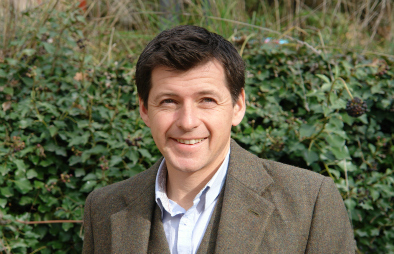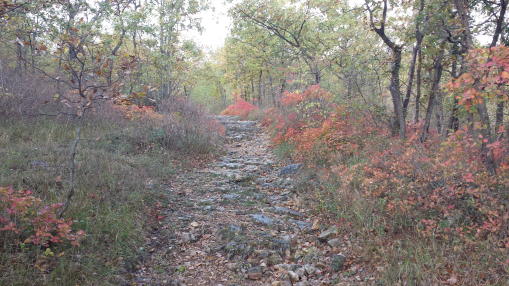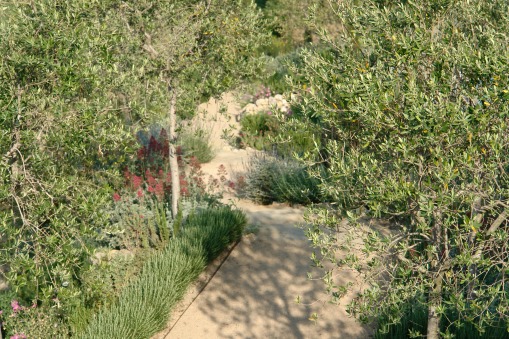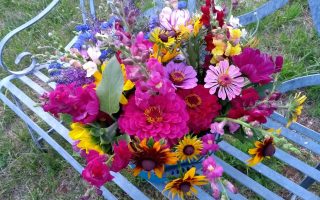Lessons from the Landscape

by James Basson
Right plant, right place
A garden is typically made up of three main elements: Hardscape – the pathways, driveways, paved surfaces and play areas; Softscape – the vegetation within the landscape; and Waterscape – the use of water on the grounds.
For the purpose of this article, I went back to nature to study how these three elements interact and to see what I could learn from the natural landscape for use in our own gardens. This led me to Le Bois de Gourdon, one of my favourite areas to walk with the family where stunted oak woodland, rocky outcrops and gentle slopes amble above the cliffs of Gourdon and below the cliffs of Caussols. Plant life here is rich and varied, as the hills roll and water springs from a thousand tiny sources and runs down into parched limestone pavements.
There is a particular footpath that I regularly take cutting across a steep bank above the road to Gourdon from Pré du Lac. The line of this pathway is always fascinating and unpredictable as it exposes and hides thousands of little vignettes of vegetation and landscape, hugging the contours of the land. At one spot, the landscape opens up to a small clearing, which completely embodies what I’m trying to achieve in the gardens I create: the land slopes up from the pathway to a stunted woodland in the back of the space.

Underfoot the first crocus is appearing amongst the stones of the pathway, on the very fringes of the vegetation. Here they snatch the first opportunity they can to flower before deciduous vegetation gets going again in the spring. We rarely plant bulbs in pathways imagining that they will be damaged, trodden on and uncared for. In this natural setting, there is very little competition for these small, delicate plants and boars find it hard to dig them up amongst the stones. This is ideal, as opposed to the perennials being crowded out or dwarfed by the surrounding flowers. Furthermore, the fringes of the path blend perfectly into the surrounding vegetation. This is demonstrated by plant life taking hold as the foot passage and stones diminish. And the use of one hard material creates a unity of form.
What is so remarkable to a Mediterranean gardener is the stability of the vegetation. The different growing mediums creates a range of tones and collections of species. All these plants have reached a state of constancy, which to a gardener means no weeding, no pruning and in fact no maintenance, with the bonus of creating a landscape which is pleasant to be in. But just what creates this stability? Simply put, the lack of resources. There is very little water in the summer and in winter, and very little soil. Add sometimes to this the searing summer heat and cold winter. We spend a fortune improving our soils, removing stones and planting flora, which are chosen for their flowers not their situation. Remember, “Right plant, right place”.
The last but equally central element of the garden is water. Personally, every time I find water in the landscape I am drawn to it. In the Alpes Maritimes water is plentiful, sometimes on the surface, sometimes underground and with seasonal variation.

But how can we incorporate this into the garden? By creating water features in the landscapes that provide that same plentiful sense. Following the language of the natural landscape, spilling out from the base of walls, coursing down impermeable areas, disappearing into the ground once it is permeable again or finishing in pools. It is how this seasonal musicality of water flow that is the most important lesson to learn from the natural landscape.
The natural landscape really is a limitless source of ideas for garden design, be it for the interaction and combinations of plants in the hard landscape or the way water finds its course. The next time you take a walk or go for a drive in your local area, take a closer look at the various elements and be inspired for your own garden – you may be surprised at what you’ll find!
• With thanks to James Basson
James Basson is an international garden designer, based in Monaco who specialises in dry, sustainable gardens that mix contemporary design with traditional skills. His designs have received international recognition and numerous awards around the world – at the ‘RHS Chelsea Flower Show’ and the ‘RHS Hampton Court Flower Show’ in the UK; at the ‘Gardening World Cup’ in Japan and at the ‘PHS Philadelphia Flower Show’. Two Gold Medals highlight the awards, received for the garden ‘After the Fire’ at the ‘Chelsea Flower Show’ and for the garden ‘Dulce et Decorum est’ at the ‘Gardening World Cup’.
www.scapedesign.com
Share to: Facebook Twitter LinkedIn Email
More in family, garden, land, language, summer
Leave a reply
Your email address will not be published. Required fields are marked *



